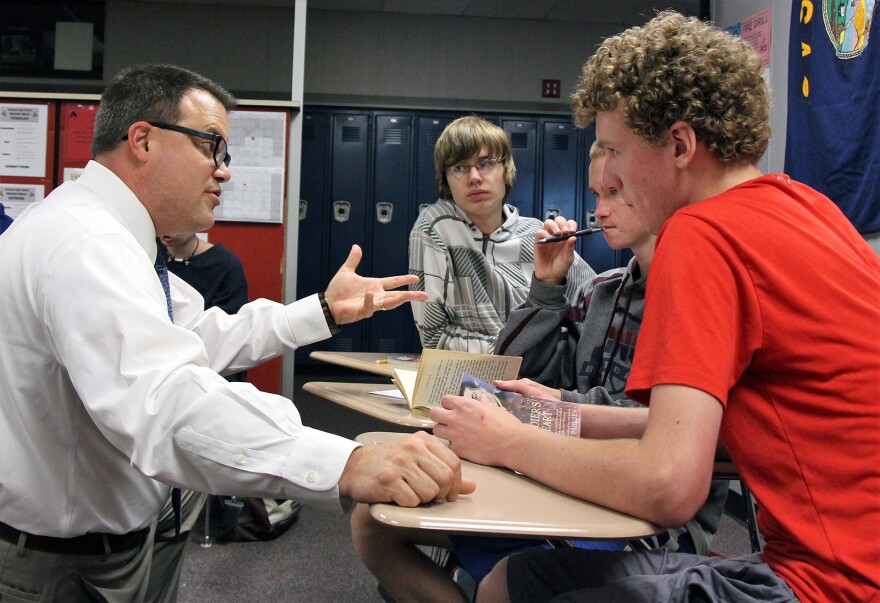Tens of millions of dollars in extra state funding that legislators approved this spring amid pressure from an ongoing school finance lawsuit could go toward raising teacher pay.
In recent weeks, news reports point to school boards throughout the state adjusting pay this year.
However, there’s no statewide data yet on how much teacher compensation will grow compared to last school year. That means it’s unclear whether the average change will keep pace with inflation or even exceed it.
The latter could be a sign that school districts are jumping at the chance to offer more competitive salary packages.
Some parts of the state — particularly high-poverty urban areas and southwest Kansas — are experiencing a teacher shortage. And after stronger growth in the mid-2000s, average teacher salaries across Kansas slowed and fell behind inflation following the 2008 recession and cuts to state aid, according to a recent Kansas Association of School Boards analysis.
Related story: Brownback signs school funding bill with $284 million increase
Nathan McAlister, a Topeka-area history teacher whose pay was frozen for three years during that period, said this financial stagnation was difficult for some educators.
“While you’re living through that — that frozen situation — insurance costs could go up, utility costs could go up,” he said. “Your kids are still growing up, they still have to go to college, they still have to have clothes.”
The lost income was one factor in McAlister’s recent decision to switch from rural Royal Valley Middle School in Jackson County — where he had taught for 13 years and won a National History Teacher of the Year Award — to Seaman High School in suburban Topeka.
Though salaries did move up again in Royal Valley, he said switching to Seaman allowed him to restore his compensation to close what he would have been earning at Royal Valley absent a freeze. But he said he doesn’t blame Royal Valley officials for the halt in experience-based raises during hard times in 2009-2012 or for the fact that teachers are now earning less than what they would have been otherwise.

“If Royal Valley had had the money, they would have made up all those years of experience for every single teacher in their district,” he said.
The Kansas Association of School Boards analysis says average teacher salaries are about $4,500 behind inflation since 2010. If districts bumped all teacher salaries this year to where they would be had pay kept pace with inflation, it would cost $175 million, the association estimates.
The question of how much schools need for adequate teacher pay could play into a much-anticipated Kansas Supreme Court ruling.
The court will decide whether the Legislature’s addition of about $195 million in funding for the 2017-18 school year and about $100 million for the year after that meets the state’s constitutional obligations to fund public education.
Lawyers for the state argue funds are reasonable and sufficient to achieve better outcomes for Kansas students, including the quarter of children struggling with math and reading skills, which the justices have identified as a key concern.
The question of how much schools need for adequate teacher pay could play into a much-anticipated Kansas Supreme Court ruling.
The state is drawing in part on a legislative research analysis of spending at 41 school districts with noteworthy academic achievement, from which it has extrapolated what it says are adequate funding levels.
But the plaintiffs in the case — Gannon v. Kansas, a seven-year lawsuit that accuses the state of underfunding public schools — argue three times as much is needed, and teacher compensation factors into their arguments.
In a brief this summer to the court, the plaintiffs’ lawyers estimate 2.5 percent raises for teachers across the state this year would eat up about $85 million of the $195 million influx.
They argue raises make sense because recruiting and retaining quality teachers is vital to educating children, but they are seeking to convince the court that the combination of this expense and the fact that other costs rise annually due to inflation will add up quickly.
This will leave too little money, they say, for the type of ambitious academic initiatives needed to resolve systemic achievement gaps among children struggling in school, who often come from disadvantaged socioeconomic backgrounds.
The latest round of oral arguments in Gannon v. Kansas took place in July. It’s unclear when the justices will hand down their ruling. It could be a matter of days, weeks or months.
If the court sides with the state, it will end the years-long legal battle. It’s also possible the justices will find funding inadequate for this school year or for coming years.
Lawmakers begin their next session in January, though a special session could be needed before then depending on the timing and outcome of the ruling.
Celia Llopis-Jepsen is a reporter for the Kansas News Service, a collaboration of KCUR, Kansas Public Radio and KMUW covering health, education and politics. You can reach her on Twitter @Celia_LJ. Kansas News Service stories and photos may be republished at no cost with proper attribution and a link back to kcur.org.







